The Best Glasses & Lenses Options for Nearsightedness
Home / Nearsightedness (Myopia) /
Last Updated:
Nearsightedness (myopia) is one of the most common refractive error eye conditions in the world. With nearsightedness, people have difficulty seeing objects in the distance, but with the right lens for nearsightedness, you may be able to see clearly.
Table of Contents
Due to how common myopia is, there are many well-developed glasses and lens options for correcting nearsightedness. Single-prescription eyeglasses and contact lenses are the most common way to correct for myopia, though new research suggests multifocal lenses are very effective at slowing the progression of the condition.
Prescription lenses can be purchased from a wide selection of online and brick-and-mortar retailers. Hundreds of glasses and lens options for nearsightedness are accessible and affordable. They can even be delivered right to your doorstep.
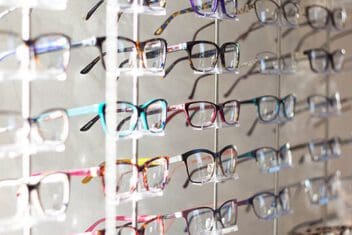
If this is your first time getting prescription glasses, a comprehensive eye exam is the best place to start. An eye care professional will review your health history, assess your current eye health, and provide accurate glasses and contact lenses prescriptions, if needed. With a vision prescription in hand, you can visit any eyewear retailer, online or in person, to find the perfect pair of glasses for you.
If you have any level of vision loss or impairment, you should be offered corrective eyewear. If you are unsure of how bad your vision is, visit an eye care professional for an eye exam. They can determine what type of corrective eyewear will be the most beneficial for you.
What Is Nearsightedness?
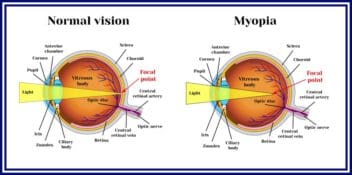
Nearsightedness, also known as myopia, is a common vision problem that makes distant objects appear blurry even when close objects remain perfectly visible. The condition is primarily hereditary, so the majority of people that have it are born with it. It worsens during childhood and adolescence and continues throughout life.
Myopia results from the inconsistent shaping of the cornea and lens, which causes light rays to bend improperly, making images appear just in front of the retina instead of on it. This is called a refractive error and is the reason why nearsightedness causes distant objects to become blurry.
You deserve clear vision. We can help.
With 135+ locations and over 2.5 million procedures performed, our board-certified eye surgeons deliver results you can trust. Your journey to better vision starts here.
Currently, over 40 percent of people in the U.S. have myopia, explains the My Myopia awareness campaign. The campaign expects that over 50 percent of children and adults will have some degree of nearsightedness by 2050. Because of this “myopia epidemic,” it is important for individuals, parents, and eye care professionals to be aware of the best options for myopia management.
The Best Glasses & Lenses for Nearsightedness
The traditional and most common way to correct for nearsightedness is by wearing prescription eyeglasses or contact lenses. Glasses and contact lenses change the way light is focused on the retina, so objects far away can be seen clearly once again.
The most-recommended solution for myopia is a diverging lens. This will separate the light that stops just short of the retina and converges it onto the back of the eye, thereby enhancing the visual clarity of faraway objects.
Single-Vision Lenses
If you’re interested in improving your vision only during certain activities, you might benefit from a single-vision lens. It’s recommended for those who only have difficulty seeing under certain circumstances, for instance, driving at night or watching TV.
Diverging Contact Lenses
Contact lenses don’t limit your peripheral vision like glasses might, and they provide clear vision.
Regular contact lenses are for periodic wearing, the same way glasses are. You can take them off before bed and put them on in the morning.
Corrective Contact Lenses
Corrective contact lenses are more rigid because they’re used to flatten/reshape the cornea to temporarily restore proper light refraction. This process is known as Corneal Refractive Therapy (CRT), and it is often used at night to restore vision during the day.
Multifocal Contact Lenses
Multifocal contact lenses can also slow down the progression of myopia in children, according to the findings of a 2014 double-blind study. These lenses slowed down the natural elongation of the eyeball by up to 31% and reduced the progression of myopia by 25%.
Researchers say that the best lenses to fix myopia are soft multifocal contact lenses with a center distance design because they focus the light in front of the retina and onto the retina itself.
Blue Light Filter Lenses
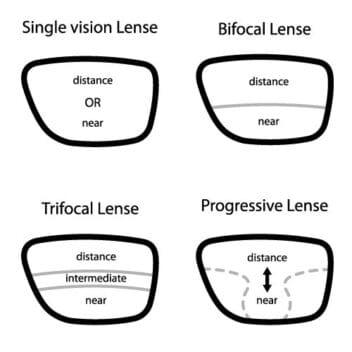
Blue light is currently being studied as a possible cause for myopia, and with the ongoing COVID-19 pandemic, more people are exposed to screens for long periods every day.
If you work from home or spend lots of time looking at a screen, investing in blue light filter lenses can prevent further progression of myopia. Blue light is also harmful to your natural sleep cycle and, therefore, can lead to significant effects on your health if left unchecked.
The good news about myopia is that there are many vision correction options available to you. If you are not interested in or do not qualify for laser eye surgery to correct your myopia, there are many glasses and lenses options available to help you achieve clear vision for all of your daily activities.
Where to Buy Lenses for Nearsightedness
If you are looking for lenses for nearsightedness, you can find affordable deals from local retailers and a wide range of eyewear sellers online. If you already have a vision prescription and don’t need to try on new frames, online retailers make it quick and easy for you to order custom lenses.
One of the best places to buy your lenses is directly through your eye doctor. This ensures safety and high quality products, and you can often get the best prices for lenses through your eye doctor.
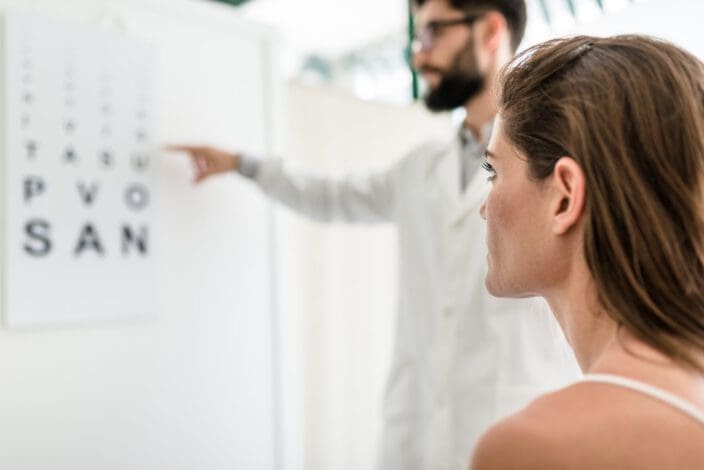
You deserve clear vision. We can help.
With 135+ locations and over 2.5 million procedures performed, our board-certified eye surgeons deliver results you can trust. Your journey to better vision starts here.
How to Get Prescription Glasses
If you are on the hunt for a pair of prescription glasses, the best place to start is with a comprehensive eye exam. Eye exams can take place at your eye doctor. You can also get them at eyewear centers and retailers that offer on-site eye exams to determine your vision prescription.
Standard tests that may be included in a comprehensive eye exam include:
- Visual acuity test (eye charts).
- Color blind test.
- Cover test.
- Ocular motility.
- Eye muscle function.
- Depth perception.
- Retinoscopy.
- Refraction.
- Autorefractor or aberrometer.
- Slit lamp.
- Glaucoma test.
- Peripheral vision.
- Pupil dilation.
- Visual field.
It is important to note that eyeglass prescriptions and contact lens prescriptions are not the same. Because glasses and contact lenses affect the eye differently, you likely need different prescription strengths for the two types of lenses. If you would like contact lenses, be sure to make that clear to the eye care professional who is conducting your eye exam.
Once you know your glasses or contact lenses prescription, you can take it to any eyewear retailer to get filled. If you have insurance that covers the cost of glasses or contact lenses, check first that it is accepted by the specific retailer.
What Warrants a Need for Prescription Glasses or Contact Lenses?
Experts from the American Optometric Association (AOA) explain that anyone with any level of nearsightedness should be offered myopia control. Multifocal lenses can help the condition from getting worse, but anyone struggling with achieving clear vision should seek corrective eyewear of some type.
Common symptoms that may indicate a need for glasses or contact lenses include:
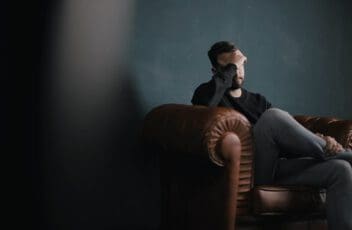
- Blurry vision.
- Double vision.
- Objects appearing hazy or fuzzy.
- Headaches.
- Squinting often.
- Eye strain.
- Seeing auras or halos around objects in bright light.
- Distorted vision.
- Poor night driving vision.
According to AOA, more than 150 million people in the U.S. wear some form of corrective eyewear. About 37 million people wear contact lenses. If you think you may benefit from corrective lenses, you are not alone.
If you have questions about your eye health, start by speaking with an eye care provider today.
You deserve clear vision. We can help.
With 135+ locations and over 2.5 million procedures performed, our board-certified eye surgeons deliver results you can trust. Your journey to better vision starts here.
References
- Advice & Actions: Creating a Myopia Management Specialty. (September 2019). My Myopia.
- Eye Health Statistics. (2015). American Optometric Association.
- Eye Exam and Vision Testing Basics. (December 2018). American Optometric Association.
- Multifocal Contact Lens Effective at Treating Myopia in Kids. (April 2016). American Optometric Association.
- Myopia (Nearsightedness). American Optometric Association.
- Nearsightedness and Its Correction. The Physics Classroom.
- Nearsightedness, Farsightedness and Astigmatism. Johns Hopkins Medicine.
- Nearsightedness (Myopia) Tables. (July 2019). National Eye Institute.
- Refractive Errors. (July 2019). National Eye Institute.
- The Effect of Blue-light Filtering Spectacle Lenses on Myopia Progression in Schoolchildren. (June 8, 2021). ClinicalTrials.gov.
- Multifocal contact lens effective at treating myopia in kids. (April 25, 2016). American Optometric Association.
- AOA promotes eye health to video gamers. (March 22, 2018). Helio.
This content is for informational purposes only. It may have been reviewed by a licensed physician, but is not intended to serve as a substitute for professional medical advice. Always consult your healthcare provider with any health concerns. For more, read our Privacy Policy and Editorial Policy.